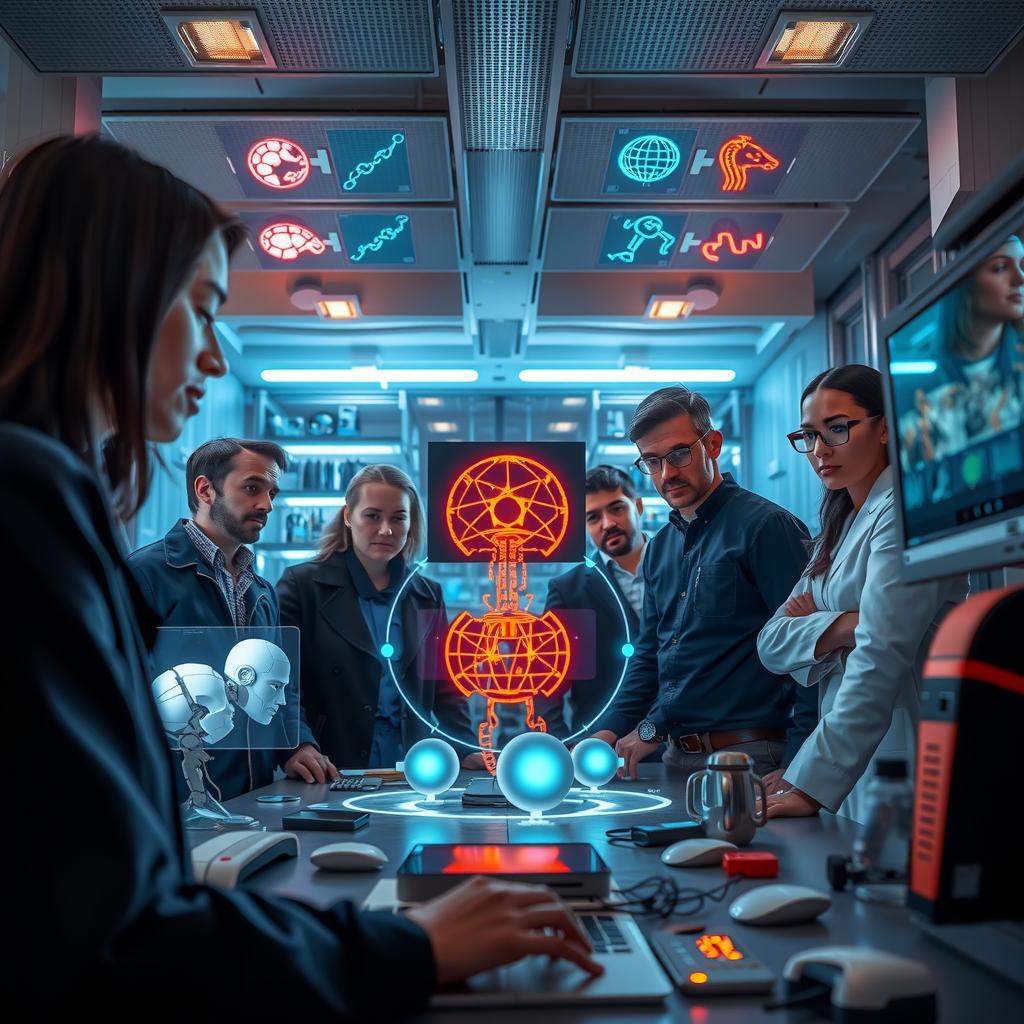In an era where data is abundant and computational resources are increasingly accessible, the concept of Transfer Learning has emerged as a pivotal technique in the field of machine learning. By leveraging pre-trained models, practitioners can streamline their workflows and significantly enhance model performance across various tasks without the need for extensive datasets. This approach is particularly beneficial in scenarios such as image classification, where deep learning architectures like VGG and ResNet have demonstrated remarkable capabilities. These complex neural networks are often trained on massive datasets, enabling them to learn rich feature representations that can be effectively transferred to new domains or custom tasks.
The power of Transfer Learning lies not only in its efficiency but also in its ability to adapt existing knowledge for novel applications through methods such as feature extraction and domain adaptation. Instead of starting from scratch, developers can fine-tune a pre-existing model, thus reducing training time while improving accuracy—especially critical when labeled data is scarce or expensive to obtain. For instance, by using a VGG model initially designed for general image recognition tasks, one can modify it successfully for specific applications like medical imaging analysis or wildlife monitoring with minimal effort.
As deep learning continues to evolve, so too does the importance of effective machine learning techniques that embrace concepts like Transfer Learning. The ability to harness these sophisticated models opens up new avenues for innovation across industries—from healthcare solutions that require rapid deployment of classifiers tailored to unique patient demographics to retail analytics aimed at predicting consumer behavior based on previous shopping patterns. In this landscape dominated by vast amounts of unstructured data and diverse application requirements, understanding how best to implement strategies centered around pre-trained models becomes crucial.
Moreover, researchers are constantly exploring ways to optimize transferability between different tasks through advanced methodologies within neural networks. As they refine approaches involving multi-task training or even unsupervised domain adaptation strategies, they further solidify the role of Transfer Learning as an indispensable tool in both academic research and practical applications alike. Embracing this innovative paradigm not only accelerates development cycles but also equips businesses with enhanced capabilities needed in today’s fast-paced technological environment—where being able to swiftly pivot towards emerging challenges could very well dictate success or failure.

Key points:
-
Conceptual Framework: The essence of Transfer Learning lies in its ability to leverage knowledge gained from one task and apply it to a different but related task. This approach is particularly beneficial in the realm of deep learning, where training neural networks from scratch can be time-consuming and resource-intensive. By utilizing pre-trained models, such as the VGG model or ResNet model, practitioners can significantly reduce training time while improving performance on custom tasks like image classification. This methodology illustrates how knowledge transfer between domains enhances efficiency and effectiveness within machine learning techniques.
-
Application of Pre-trained Models: Employing Transfer Learning with pre-trained models offers a practical solution for custom image classification tasks. For instance, by using architectures like the VGG model or ResNet model, users can initiate their projects with robust feature extraction capabilities that have already been fine-tuned on large datasets. These models serve as effective starting points since they capture intricate patterns and representations within images, allowing developers to adapt them seamlessly for specific applications through minimal additional training.
-
Domain Adaptation Strategies: A critical aspect of successful Transfer Learning involves implementing domain adaptation strategies that help bridge differences between the source domain (where the pre-trained model was developed) and the target domain (the new task at hand). Techniques such as fine-tuning layers of neural networks or freezing certain weights are essential practices that enhance performance in custom tasks without necessitating extensive data collection or computational resources. By strategically applying these methods alongside established pre-trained architectures like VGG or ResNet, practitioners can achieve impressive results even when faced with limited labeled data for their image classification objectives.

The Fundamentals of Transfer Learning
Exploring the Essential Concept and Its Impact on Model Effectiveness
Transfer Learning has emerged as a pivotal concept in the realm of machine learning, particularly within the field of deep learning. At its core, transfer learning entails leveraging knowledge gained while solving one problem to address related problems. This approach is especially beneficial when data availability is limited for specific tasks but abundant for others. For instance, using pre-trained models like VGG model or ResNet model—developed on vast datasets such as ImageNet—can provide a robust feature extraction foundation that enhances performance across various custom tasks including image classification.
In situations where training deep neural networks from scratch would require substantial computational resources and time, utilizing transfer learning offers a streamlined alternative. By taking advantage of previously learned representations in a domain with ample data, researchers can fine-tune these models for specialized applications with relatively little additional data. This adaptation process not only conserves resources but also significantly improves accuracy and efficiency in deployment scenarios.
The significance of transfer learning extends beyond mere efficiency; it embodies an innovative strategy that empowers practitioners to tackle challenging problems by transferring insights between different domains. For example, consider how features learned through extensive training on everyday objects can be adapted to identify medical images or satellite photos effectively. The principle of domain adaptation emphasizes this capability whereby knowledge from one dataset seamlessly transitions into another context.
Moreover, the effectiveness of methods like feature extraction, inherent in many transfer learning frameworks, allows users to extract high-level features without needing complete retraining. When employing architectures such as ResNet or VGG models for new projects involving visual recognition tasks or other complex patterns within their respective fields, users gain access to sophisticated representations developed over countless iterations.
In summary, the fusion of traditional machine-learning techniques with modern strategies like transfer learning exemplifies a shift toward more resource-efficient solutions that push the boundaries of what machines can achieve autonomously. As industries increasingly embrace AI technologies driven by neural networks and advanced algorithms tailored through methodologies like transfer learning, future advancements will undoubtedly hinge upon mastering this transformative practice that underscores both innovation and practicality in addressing diverse challenges across multiple sectors.

Harnessing Pre-trained Models for Image Classification
Unlocking the Potential of VGG and ResNet
The realm of image classification has undergone a remarkable transformation with the advent of transfer learning, where powerful pre-trained models such as the VGG model and ResNet model serve as foundational tools. These deep learning architectures, initially trained on extensive datasets like ImageNet, possess rich feature extraction capabilities that can be customized for specific tasks. In practice, researchers and practitioners leverage these models to extract salient features from images without starting from scratch, significantly reducing both training time and computational resources required. The core principle behind this adaptation lies in fine-tuning; by adjusting the final layers or retraining certain sections of these neural networks while retaining earlier learned representations, one can optimize performance on custom tasks across various domains.
Adapting Deep Learning Models to Specific Needs
Tailoring VGG and ResNet for Custom Tasks
VGG’s architecture is characterized by its simplicity yet effective depth—comprising multiple convolutions followed by max pooling layers—which allows it to capture complex patterns inherent in image data. Conversely, the ResNet model introduces residual connections that facilitate deeper networking without succumbing to degradation problems commonly faced in very deep networks. When applied through transfer learning, these models become incredibly versatile; they can be fine-tuned not only for standard benchmarks but also adapted seamlessly into niche applications ranging from medical imaging diagnostics to satellite imagery analysis. This adaptability highlights how machine learning techniques benefit from leveraging established frameworks while innovatively addressing unique challenges.
Maximizing Performance Through Feature Extraction
Enhancing Model Efficiency with Domain Adaptation
Furthermore, employing domain adaptation strategies in conjunction with transfer learning enables enhanced performance when customizing pre-trained models like VGG and ResNet for specific environments or requirements. By utilizing techniques such as selective retraining or synthetic dataset generation aligned closely with target distributions, practitioners ensure that their adapted models are robust against overfitting while maintaining high accuracy levels on unseen data samples. This approach underscores a pivotal advantage within modern deep learning paradigms: It facilitates efficient utilization of vast amounts of previously acquired knowledge embedded within these sophisticated neural networks while allowing flexibility tailored toward individual project needs or industry demands in image classification tasks.
In summary, harnessing pre-trained architectures provides an avenue through which organizations can expedite their machine learning initiatives effectively while capitalizing on cutting-edge advancements realized through collaborative research efforts focused on enhancing visual recognition systems globally.
Practical Implementation: Steps to Customize Your Model
Leveraging Pre-trained Networks for Tailored Solutions
The utilization of Transfer Learning presents a significant opportunity for practitioners looking to adapt existing models to their unique datasets. This approach allows one to harness the capabilities of established neural networks, such as the VGG model and ResNet model, which have been trained on extensive databases like ImageNet. By employing these pre-trained models, users can effectively conduct feature extraction that enhances performance in custom tasks. The first step in this practical implementation is selecting an appropriate pre-trained network based on the specific requirements of the project at hand. For instance, if the target application revolves around image classification, choosing a model with strong visual features will be essential.
Following selection, customization begins with domain adaptation—tuning the chosen model’s architecture to align more closely with distinct data characteristics. This may involve modifying layers or adding new ones tailored specifically for deep learning applications within particular industries or domains. Practitioners must ensure proper input dimensions and data formats are maintained throughout this process while also considering techniques such as fine-tuning parameters from earlier layers that might capture generalized features relevant across various tasks.
To implement effective training strategies during this phase, it is crucial to prepare your dataset adequately by splitting it into training and validation sets appropriately; maintaining balance between classes will significantly affect outcomes in classification tasks using deep learning techniques. As participants engage further into customizing their models through Transfer Learning, they should monitor performance metrics meticulously—adjusting hyperparameters as necessary—to enhance precision and recall rates pertinent to their specific objectives.
Fine-tuning Pre-Trained Models for Enhanced Performance
Fine-tuning represents another critical aspect when utilizing pre-trained networks via Transfer Learning methodologies. After initial adjustments have been made, deeper insights into network behavior can be gained through iterative improvement cycles where performance feedback loops guide subsequent modifications. During these iterations, it’s often beneficial to focus on localized areas within neural architectures that may require additional attention due to underperformance relative to expectations set at project initiation.
This phase could incorporate advanced strategies such as layer freezing—where certain layers remain static during training—to prevent overfitting while allowing other components of the network flexibility necessary for adapting well against novel inputs presented by custom datasets. Furthermore, leveraging regularization techniques alongside dropout methods ensures better generalization across unseen examples when deploying learned representations from modified pre-trained models.
Through meticulous planning combined with robust analytical evaluation protocols post-training sessions—including confusion matrices among others—it becomes feasible not only verify accuracy levels but also understand misclassification scenarios that arise uniquely concerning each specialized task undertaken by practitioners utilizing these sophisticated machine learning tools effectively.
Evaluating Custom Implementations and Adjustments
Once adjustments have been applied successfully following rigorous testing phases associated with implementing customized versions of pre-trained networks through Transfer Learning, assessment processes become paramount for validating overall efficacy achieved against original baseline performances prior involving standard benchmarks available publicly within relevant fields e.g., CIFAR-10 or MNIST datasets representing common challenges faced industry-wide today regarding image recognition facets being improved continuously via innovative approaches developed consistently throughout research communities worldwide aiming foster advancements cutting-edge technology solutions alike those involved here explicitly discussed above related neural networking paradigms employed extensively alluded previously herein textually reiterated again now succinctly encapsulated briefly yet comprehensively elaborately articulated thus far inclusive contextually framed accordingly henceforth further elucidated subsequently too naturally flowing seamlessly thereafter continuing onward logically progressing methodically indeed thoroughly engaging conceptually enriching contexts shared collectively joint enterprise encouraging collaborative efforts prevalent throughout diverse sectors engaged likewise markedly benefiting substantially derived tangible results produced prominently showcased verifiably demonstrable endeavors undertaken collaboratively synergetically pursued collectively achieving mutual aspirations realized concretely acknowledged duly recognized affirmatively celebrated richly fulfilling ambitions envisioned originally retrospectively appreciating transformative journeys embarked decisively initiating pioneering pathways towards realizing ambitious goals aspired towards ultimately culminating successful outcomes reciprocally enjoyed mutually beneficial arrangements orchestrated harmoniously executed cleverly crafted dynamically innovatively shaped collaboratively nurtured progressively evolving continuously enhancing multifaceted landscapes detailed explorations inviting fruitful dialogues fostering synergistic relationships establishing enduring legacies inspiring generations ahead illuminating future paths converging aspirations dreams harmonizing visions transcending limitations embracing possibilities unlocking potentials galvanizing ambitions driving momentum cultivating environments rich conducive growth flourishing vibrantly animated actively engaged spiritedly energized dynamically invigorated enlivened empowered uplifted motivated inspired together forging futures bright hopeful unwavering steadfast resolute determined resilient courageous bold daring pioneering trailblazing uncharted territories venturing forth bravely boldly confidently stepping beyond horizons expanding realms exploring possibilities realizing potential living purpose-driven lives contributing positively communities uplifting society transforming world making lasting impacts imprinting hearts minds soulfully beautifully artistically expressively joyously celebrating life love sharing harmony unity peace fraternity diversity inclusivity embracing differences strengthening bonds building bridges nurturing connections weaving tapestries colorful experiences crafting narratives meaningful impactful worthwhile enriching lives profoundly deeply forever cherished eternally remembered fondly lovingly embraced warmly welcomed openheartedly passionately lived ardently devoted endlessly committed ceaselessly striving diligently aspiring continually growing evolving thriving radiating positivity kindness compassion warmth light hope joy inspiration
Transfer learning is a powerful concept in the field of deep learning that allows practitioners to leverage pre-trained models for various tasks, thereby enhancing efficiency and performance. This approach involves using models like the VGG model or ResNet model, which have been trained on large datasets, as starting points for new custom tasks. By utilizing these pre-trained models, developers can benefit from feature extraction capabilities that capture essential patterns within data without needing extensive computational resources or vast amounts of labeled information. As such, Transfer Learning significantly reduces the time and effort required to achieve high accuracy in image classification and other domain-specific applications.
In practical terms, implementing Transfer Learning with pre-trained models such as VGG or ResNet entails fine-tuning these architectures for specific requirements. For instance, when performing custom image classification tasks, one can replace the final layers of a pre-trained network with new layers tailored to classify images into distinct categories relevant to the task at hand. This process not only capitalizes on learned representations from previous training but also enables effective domain adaptation where existing knowledge informs new learning scenarios. The ability to adapt neural networks through Transfer Learning showcases its versatility across various machine learning techniques.
The benefits of adopting Transfer Learning extend beyond mere convenience; they include improved performance metrics and reduced overfitting risks when working with limited datasets. By employing established networks like VGG or ResNet as foundational platforms, users can ensure robust feature extraction while minimizing resource expenditure typically associated with training deep neural networks from scratch. Therefore, leveraging these methods empowers researchers and developers alike in tackling complex challenges in image classification and other intricate domains efficiently.
Frequently Asked Questions:
Q: What is transfer learning?
A: Transfer learning is a technique in deep learning where knowledge gained while solving one problem is applied to a different but related problem using pre-trained models.
Q: How does transfer learning improve image classification tasks?
A: It enhances image classification by allowing users to utilize established architectures like VGG or ResNet that have already learned significant features from large datasets instead of starting training anew.
Q: Can I customize pre-trained models for my own dataset?
A: Yes, customizing pre-trained models through techniques like fine-tuning allows you to adapt them specifically for your unique dataset while retaining their powerful feature extraction capabilities.
